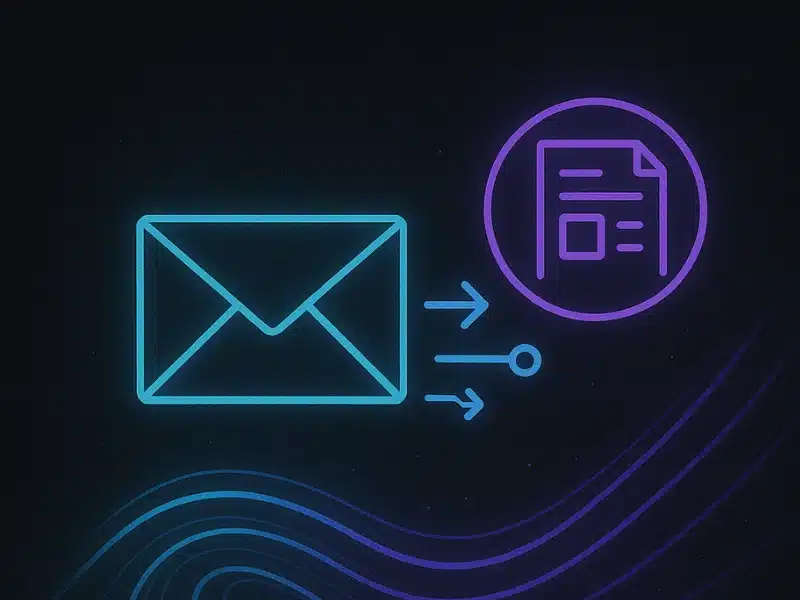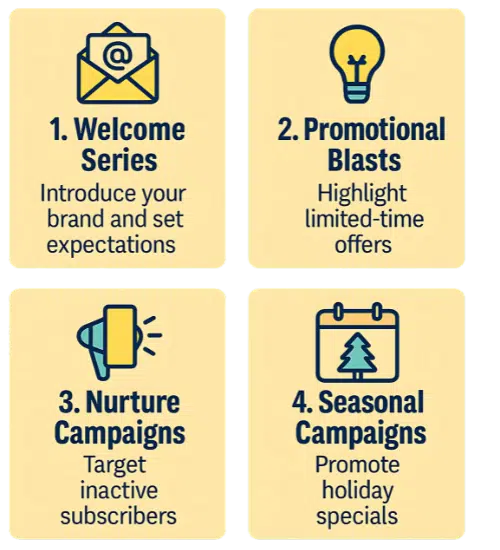Blog Post
Unlock Real Results with Email Deployment
- Update
- Read Time: 11 Min
Share

Reach customers, get more responses, and turn every email marketing campaign into a sale for your business.
What Is Email Deployment?

Email deployment is the entire process of building, preparing, and delivering your email campaigns.
It covers everything from list building, management, creation, authentication protocols, and timing. It ensures your outreach hits your customers’ inboxes, not their spam folders.
Throughout this article, we will provide you with complete guidance on successfully executing your next email marketing campaign and driving revenue and growth for your business.
Digital Mail: Winning the Marketing Battle 50 Years Later
Digital mail is one of the oldest methods of marketing on the internet. Because of this, it almost feels ancient compared to the many other digital channels available today. But even over 50 years since the first email was sent over the web, it is still one of the easiest and highest returns on investment in marketing today.
It continues to outperform nearly all other digital marketing strategies. Research from Litmus shows that for every $1 spent on email marketing, the average return is $38.

Digital mail is direct, personal, and cost-effective. Unlike social media algorithms or ad platforms that constantly change, your email list is your own. It’s full of engaged and targeted leads ready to hear what you have to say. Even better, you get to control the frequency and message, without paying per click or impression.
Effective email deployment can drive real results, whether you’re a local mom-and-pop or a large-scale operation.
Building a Healthy Email List
A successful email deployment strategy begins with having a solid contact list. The quality of your list will determine the success of your campaign. The first step in building your list is getting permission to send marketing messages to them.
This is much easier if you already have a steady stream of clients, but it’s more difficult if you’re struggling to get traffic to your business. Struggling to get traffic is frustrating for many business owners, especially in the early stages of their business.
It may result in them taking desperate measures such as buying or using the scraped list. This might seem like a shortcut, but these are usually filled with invalid addresses. Sending a bought list is the fastest way to damage your sender reputation, waste money on undeliverable contacts, and end up in spam folders.
A healthy list, by contrast, is filled with real people who want to hear from you, which translates into higher open rates, stronger engagement, and more sales.
There are many ethical, high-performing ways to collect an email address: website opt-ins using a form or pop-up on high-traffic pages, asking for a customer’s address at the checkout, and offering free value are just a few.

Try creating a QR Code that takes customers to a webpage that provides 10% off your next order and an opt-in form. The key is to clarify the value that subscribers get in return. A discount, early access, helpful content, or special treatment? They’ll gladly give you the green light when they see the benefit.
Don't
- Buy or rent contact lists from third parties
- Add people to your list without consent
- Hide the unsubscribe link
- Add contest entries to your list without permission
- Keep sending to hard bounces or invalid inboxes
- Send bulk outreaches from your personal address
Do
- Use clear opt-in checkboxes on all forms
- Explain what subscribers will receive
- Confirm sign-ups with a welcome email
- Collect emails at events with a signup sheet or tablet
- Clean your list regularly to remove inactive contacts
- Offer a small incentive to join (discount, download, etc.)
Campaign Types That Convert
Not all campaigns serve the same purpose; the most effective campaigns are built around one clear goal. Whether building brand awareness, promoting a limited-time offer, or reactivating cold leads, every campaign should have a well-defined and achievable outcome.
Think of your digital mail as part of an ongoing conversation with your audience; the goal is to guide them towards one action. When messaging is scattered or lacks direction, it confuses the reader. Avoid mixed signals, and always include a compelling call to action.
For service-based businesses, the right campaign at the right time can lead to more bookings, more loyal customers, and better long-term growth. Below are five campaign types that consistently deliver engagement and results.

Content Creation: Writing for Results
Great email content should be a natural conversation, not a sales pitch. The goal is to create trust, deliver value, and guide the reader toward a single, explicit action.
Use important, not-so-well-known methods to boost your deliverability and effectiveness.
Subject Lines:
Keep them short (under 50 characters), curiosity-driven, and personalized. Adding the recipient’s name makes the inbox message feel important and targeted to the recipient, not some generic email blast. Doing so can dramatically increase open rates.
Avoid spammy words like:
“Free,” “Guaranteed,” “Act now,” “Buy,” “Earn cash,” “Risk-free,”
Overuse of exclamation marks (!!)
ALL CAPS
Providers like Google, Yahoo, and others have gotten smarter at detecting spam and now use advanced filters to flag digital mail with overly promotional or deceptive subject lines.
Words like these can instantly lower deliverability and send your message straight to the junk folder, mainly when used in subject lines.
Body Content:
Focus on benefits, not features. Use short paragraphs and bullet points for readability, especially on mobile. Ideal length? 75–200 words for promotional or transactional emails, and up to 400 words for educational content like newsletters.
Make it skimmable and speak like a human. If it sounds like marketing, it probably won’t convert.
CTAs (Call to Action):
Each email should have one primary CTA. Whether it’s “Book Now,” “Claim Your Offer,” or “Leave a Review,” don’t confuse the reader with too many options. Place a button or bold link above the fold and near the end.

Visuals: Make It Easy on the Eyes
The right visuals can boost engagement and reinforce your message, but too many can distract or trigger spam filters. Aim for a clean layout that supports the copy without overpowering it.
Use One Clear Image Per Message: Place it near the top or beside your primary call-to-action.
Don’t Send Image-Only Messages: Always include real text so email systems and screen readers can read it.
Add Alt Text: This helps people (and inboxes) understand what the image is about.
Keep Images Under 1 MB: Smaller files load faster and are less likely to hurt your deliverability.
Use branded visuals with your logo and color palette to boost recognition and trust. A well-placed, professional image can be the difference between a click and a skip.
Psychological Triggers
You got the person to open your email. Your design looks great, your subject line worked, and everything is mobile-friendly. But now what? How do you turn that attention into action?
That’s where psychological triggers come in. The most effective messages don’t just inform, they influence.
The main goal is to have the reader take action without sounding pushy. This can happen by tapping into human emotions and decision-making patterns.
Here are a few key triggers that convert casual readers into loyal customers:
Scarcity: Make people feel like they’ll miss out.
“Only 3 appointments left this week” creates a sense of limited availability and pushes quicker action.
Social Proof: Show them they’re not alone.
“Rated 5 stars by 200+ clients” builds instant trust by leveraging other people’s positive experiences.
Urgency: Add a time limit or deadline.
“Book by Friday to lock in pricing” motivates action by setting a ticking clock.
Personalization: Make it feel one-on-one.
Use their name, preferences, or past interactions. “Hi Lisa, ready to schedule your follow-up facial?” feels way more relevant than a generic blast.

Try combining triggers for stronger results. A personalized message with urgency (“Mike, only two spots left this week!”) can lift conversions significantly, especially for service-based businesses where appointments and limited capacity are part of the offer.
Sending Domain Reputation: Why It Matters
Many business owners don’t realize this, but the domain you use to send emails is closely monitored by internet service providers (ISPs). Every message you send contributes to your sender reputation, like a credit score for your email domain.
ISPs constantly evaluate your domain based on how your emails are performing and are received. High bounce rates, spam complaints, or low engagement levels can all drag down your reputation. Once your reputation drops, your email delivery begins to sink, and you are more likely to end up in the spam folder.
If you’re planning a serious email marketing campaign, strictly using a separate domain or subdomain for your campaign is smart. This way, your marketing efforts will not affect your primary business’s domain.
Just as important is to warm up the new domain slowly. Launching a domain and immediately blasting thousands of emails will raise a red flag and destroy your email deliverability immediately. Start small and gradually increase volume to build a positive history.
Make sure to clean your list every 2–3 months. Remove inactive users, bounces, and duplicates. Failing to do this harms your sender reputation and increases spam filtering.
For a deeper look at effective list cleaning methods, check out these 12 best practices for email list cleaning from Bouncify. Following these proven strategies can help maintain a strong sender reputation, minimize bounces, and boost your overall email deliverability.
Authentication Protocols
You don’t have to be a tech expert, but this part matters: to make sure your messages land in inboxes (not spam), your domain needs to be authenticated. Think of it like proving to email providers that you’re a real business, not a scammer.
There are three tools used to do this:
SPF: Tells inboxes which servers are allowed to send emails for your domain.
DKIM: Adds a digital signature to show the email is legit.
DMARC: Tells email providers what to do if something doesn’t match.
If this sounds confusing, don’t worry. With RSG’s AI email marketing packages, we can handle this for you. All we need is access to your DNS records (usually wherever your domain is hosted, like GoDaddy, Google Domains, etc.), and we’ll set everything up properly to maximize your deliverability and protect your brand.
Understanding the Key Metrics
Tracking your campaign’s performance is essential for determining whether or not your efforts are successful. This data is vital for making intelligent decisions on your email deployment strategy, including what’s working, what needs fixing, and where your growth opportunities are.

Keep an eye on them regularly, and you’ll turn email into one of your most powerful marketing tools.
Before sending to your whole list, A/B test small batches with different subject lines, send times, or CTAs. If one version outperforms the others, scale it. Let the data decide.
CAN-SPAM Laws and Legal Requirements (U.S. Based)
If you’re sending digital mail in the U.S., you must follow the CAN-SPAM Act, a law protecting consumers from spam and setting clear business rules. The good news? It’s pretty straightforward. You’re likely already on the right track if you’re honest, respectful, and transparent with your subscribers.
Here’s what you need to do to stay compliant:
Include an Easy Way to Unsubscribe: Every outreach must have a clear opt-out link.
Label it as an Ad (if needed): If your message is promotional, it should be identified.
Add Your Business Address: A valid physical mailing address must be included in every message.
Be Honest in Your Subject Line: No misleading headlines or sender names.
Process Opt-Outs Quickly: You’ll need to honor unsubscribe requests within 10 days.
For a deeper dive into compliance, the Federal Trade Commission (FTC) offers a straightforward CAN-SPAM Act Compliance Guide for Business. This guide outlines the exact steps businesses must take to stay compliant, avoid penalties, and maintain trust with their audience.
Failing to follow these rules can lead to fines and hurt your brand’s reputation.
Smarter Email Deployment with AI
AI is changing the game when it comes to email deployment.
AI can use real-time data and user behavior to make smarter decisions instead of guessing the best time to send or relying on gut instinct for subject lines. It analyzes past performance, predicts engagement patterns, and helps you send the right message to the right person at the right time, often executed through email service providers (ESPs).
This means fewer missed opportunities, higher open rates, and better results with less effort and cost for your business.
AI handles a lot of the heavy lifting and decision-making, so you can focus on running your business while the technology works to get you more bookings, clicks, and more returns on every campaign you send.
At Reisinger Strategies Group, our Done-For-You Email Marketing service puts the power of AI to work for you. We handle everything from strategy and content to smart send timing, list cleanup, and real-time optimization. While you focus on running your business, we ensure your outreach lands in inboxes and delivers the results you desire.
Wrapping Up
While AI is transforming email marketing and other business operations, many business owners struggle to integrate these tools effectively. Many choose to work with specialized partners, as explained in Why Business Owners Are Partnering with an AI Agency.
Digital mail remains one of the most powerful, cost-effective ways to grow a service-based business. It can outperform every other channel with strategy, automation, and data-backed decisions. Whether you’re sending 100 or 10,000 messages, the key is consistency, clarity, and staying compliant.
Start small, track what works, and let innovative tools (and smarter strategy) do the heavy lifting.
Written by
Reisinger Strategies Group Team
Reisinger Strategies Group helps businesses grow with AI-powered marketing solutions, from strategy to execution and built to drive real results.



